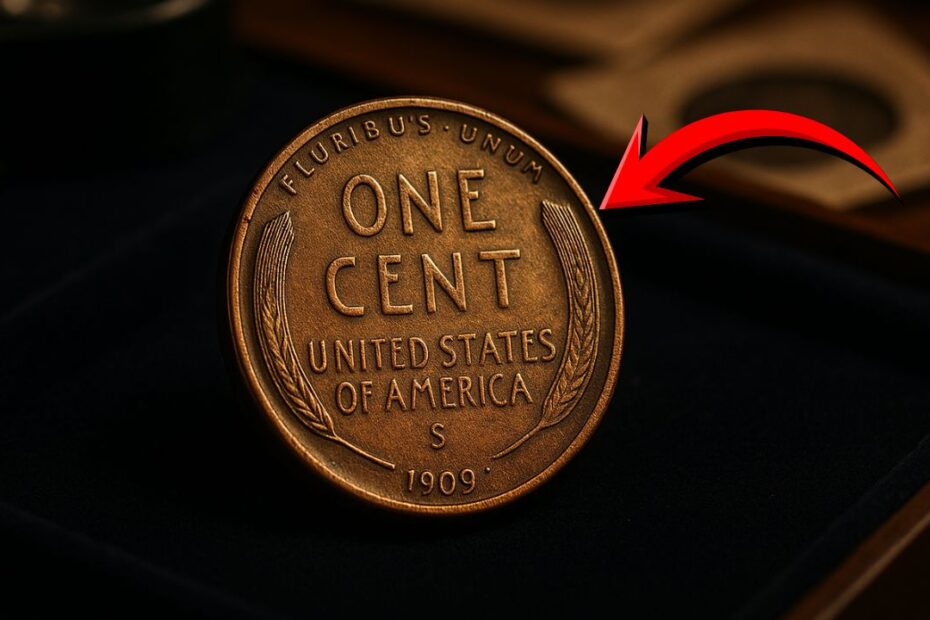The 1909‑S VDB Lincoln Cent is a coin every serious collector knows. Released in 1909 by the United States Mint at its San Francisco facility, it carries the initials “VDB” for designer Victor David Brenner on its reverse.
With a very low mintage of only 484,000, it remains one of the most collectible coins in U.S. history.
This article explores its history, specifications, why it sells for thousands today, how to recognize a genuine one, and other key facts for collectors.
Historical Background
- The 1909 cent was the first U.S. coin to feature a real person, Abraham Lincoln.
- Designed by Victor David Brenner, his initials “VDB” were placed on the reverse between the wheat stalks.
- The “S” mintmark indicates it was struck at the San Francisco Mint. The Philadelphia version without “S” is more common.
- Public complaints about the prominence of the initials caused the Mint to remove them later in 1909, making coins with the initials scarce.
Key Specifications & Production Figures
| Specification | Detail |
|---|---|
| Year | 1909 |
| Mint | San Francisco (“S” mintmark) |
| Mintage | 484,000 coins struck with “VDB” initials |
| Composition | Bronze: 95% copper, 2.5% tin, 2.5% zinc |
| Weight | 3.11 grams |
| Diameter | 19.05 mm |
| Edge | Plain |
| Design (Obverse) | Abraham Lincoln profile |
| Design (Reverse) | Two wheat stalks (“Wheat Ears”), with “VDB” initials at bottom |
Why This Penny Still Fetches High Values
- Extremely Low Mintage – Only 484,000 coins were made, making it a key date in the Lincoln cent series.
- Historical Significance – First Lincoln cent and featuring Brenner’s initials adds collector appeal.
- Immediate Scarcity – Initials were removed soon after release, leaving fewer surviving coins with “VDB”.
- High Demand – Collectors completing Lincoln cent sets must include the 1909‑S VDB.
- High Market Prices – Even lower-grade examples can sell for thousands of dollars. Exceptional coins have sold for tens of thousands.
- Authentication Importance – Many counterfeits exist, so certified authentic examples command higher premiums.
Current Value Ranges
Value depends on condition (grade) and color (brown, red & brown, red).
- Circulated examples start around $700.
- Uncirculated coins can range from $5,000 to over $22,500.
- Top mint-state examples can sell for significantly more at auction.
How to Authenticate and Spot One
- Check the “S” mintmark under the date.
- On the reverse, ensure the initials “VDB” appear between the wheat stalks.
- Verify weight (≈ 3.11 g), diameter (19.05 mm), and composition.
- Buy only coins certified by a recognized grading service or reputable dealer.
- Avoid cleaning or polishing, which reduces value.
Collector Tips
- Check older collections or inherited coins for the key date.
- Avoid coins missing the “VDB” initials or the “S” mintmark—they are less valuable.
- Compare certificate grades and auction results before purchase.
- Handle coins carefully to preserve condition and value.
The 1909‑S VDB Lincoln Cent is more than a penny; it’s a historic treasure.
Its low mintage, historical design, and quickly removed “VDB” initials make it one of the most sought-after coins.
Collectors value it highly, and even circulated examples sell for thousands.
Understanding its specifications, value, and authenticity is essential for any serious coin collector. Finding one today is like uncovering a small piece of history worth far more than its face value.
FAQs
Why does “VDB” matter so much on this penny?
The initials stand for designer Victor David Brenner. Their limited presence makes these coins rare and highly collectible.
Why is the San Francisco mint version so valuable?
The Philadelphia version had millions minted, while only 484,000 were struck at San Francisco, making it much rarer.
Can this penny still be found in circulation?
It is extremely unlikely. Most surviving coins are in collections, making discovery in everyday change very rare.
